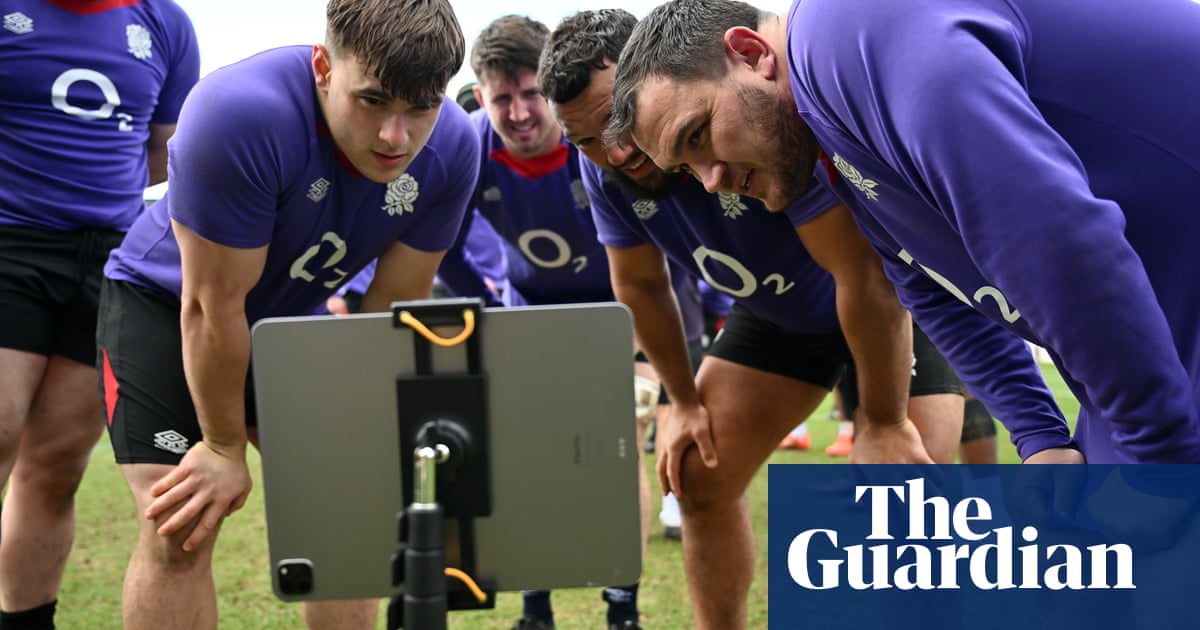How to boost your flexibility, speed and strength as a masters hurdler with advice from Neuff ambassador Mensah Elliott
“Loads of people fear the hurdles because it’s the natural human response to obstacles and potential pain, isn’t it?” Mensah Elliott jokes. “People always tell me, ‘You must be either stupid or crazy to run and jump over an obstacle at full speed’. But it’s fun. I love it. Which is good, because I’ve been doing it for 30 years.”
And, over the last three decades, Mensah has achieved something that many of us can only dream about: competing on the international stage as both a senior and a masters athlete.
Now, as many of us battle to retain even a semblance of speed and strength – not to mention mobility – Elliott defies his M45 age by still being competitive over the full 3ft 6in senior height hurdles: in February, he was invited to compete at the UK Indoor Championships in Birmingham.
So, he’s the perfect candidate to teach masters athletes how best to maintain the physical attributes required for hurdling: speed, strength, and flexibility, which is what he’ll be doing in part one of this blog.
(Stay tuned for part two, which will focus on hurdles spacing and perfecting your start).
30 years of hurdling success, with a few breaks in the mix!
Growing up in The Gambia, Elliott sprinted everywhere: to school, to the shops, to see his friends. Everywhere he went, he ran. Fast.
As a student at Saint Augustine’s High School, he excelled in athletics, competing in sprints, javelin, and shot put. And, inspired by Linford Christie’s 1992 Olympic 100m victory, he set his sights on becoming a top athlete.
After moving to England in 1993, Elliott joined Blackheath Harriers and focused on the sprints, however it wasn’t until late in the 1996 season that the hurdles became a part of Elliott’s training programme, when he tried his hand at the decathlon.
By 1999, he was among the UK’s top hurdlers, ranking fourth nationally in 2000-2001. He went on to represent Great Britain and England in major competitions, including the 2002 Commonwealth Games.
But a serious back injury cut his senior career short. After taking a year off, the pain disappeared and he gave it another go – but it wasn’t the same. Another six-year break followed before he returned as a masters athlete, this time with a better understanding of his body and how to train for longevity.
Representing The Gambia, he won silver at the 2012 World Masters Championships. He continued to make his mark, setting British, European, and World Masters records in the 60m hurdles and 110m hurdles. Over the years, he’s claimed multiple national and international titles, cementing his status as one of the world’s top masters hurdlers.
Today, Elliott remains dedicated to the sport, balancing competition with coaching. He takes pride in mentoring junior athletes, passing on his expertise and experience through the S-Factor Academy. He’s also a passionate advocate for masters athletics, promoting track and field through his voluntary role as a Neuff ambassador.
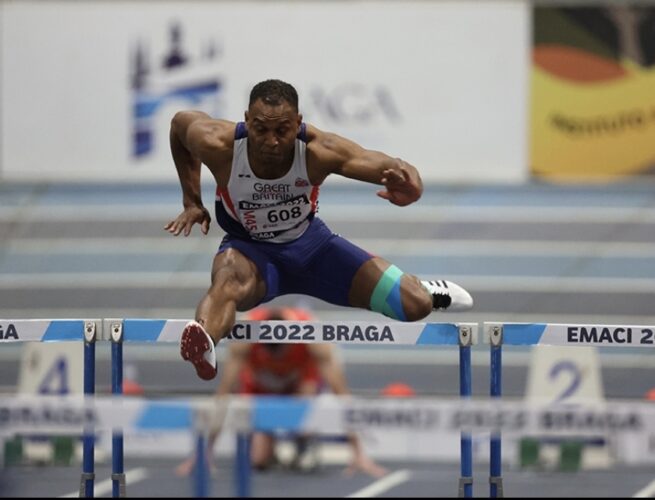
Prioritising flexibility and mobility
“As we get older and busier, we tend to be on the lazy side and neglect mobility and flexibility”, begins Elliott.
However, maintaining these two often-overlooked physical traits is one of the most important parts of his training plan, and something that he recommends all master athletes prioritise.
“I do at least half an hour of stretching and mobility every morning. It’s part of my routine now – my day doesn’t start until I’ve done that,” he adds.
He focuses on his lower back, glutes, hamstrings, and hip flexors – everything just above and just below the hips.
“If your hips are weak, and tight, then you’ll struggle with everything to do with hurdling – especially over the high hurdles!” Elliott explains.
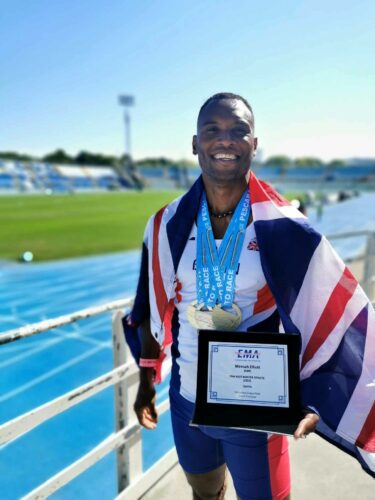
You need to be strong, but sensible!
For masters athletes, incorporating some resistance training into their routine is essential.
Whether it’s using resistance bands or lifting weights, strengthening the muscles is one of the biggest factors in staying not just competitive, but also healthy and pain-free for longer. “This isn’t just about athletics,” Elliott says. “This is about living longer and moving without pain. Right now, as I sit here talking, if I want to get up, I need muscles to do that. If they’re weak, it’s going to be harder. I’m doing this for my future health, not just my hurdling.”
And strength is one of the areas where Elliott’s approach to training has changed significantly as he’s grown older.
“When I was younger, my focus in the gym was working all the big muscles and lifting heavy weights. I just did what everyone else did,” Elliott explains.
Now, everything is specifically aimed at being as strong as possible in each phase of the hurdling motion, with a reduced focus on heavy lifting and compound movements: “It’s not about doing more; it’s about being sensible, and specific to the event,” he emphasises.
One area he now pays particular attention to is strengthening his feet and ankles, in preparation for his lead leg landing off the hurdle. “I’d say 90% of my warm-ups both on and off the track are done barefoot; and that’s to strengthen my feet, improve my balance, and develop all the smaller muscles in my body,” he explains. “When you wear trainers, they give you that cushioning. But then think about sprinting in spikes, and coming off a hurdle: the force that goes through your feet, ankles, and your whole body is huge. So I work on the small muscles from the tip of my toes all the way up to my shoulders, testing my balance by moving with no shoes on.”
But the main shift for Elliott has been reducing the weights. “You don’t have to go in and try to hit a PB or max out every time,” he explains. “Just working at 50% resistance and building strength is enough.”
He adds: “I don’t lift ‘heavy’ weights anymore. I don’t need to. The only movement I still go heavy on is deadlifts, because it works everything. But with things like cleans, I stop at 80kg. I do fast reps at 60kg. I used to clean 125kg, but I don’t need to be doing that now.”
The only exception to the heavy lifting rule is when he’s doing contrast training: completing a heavy (ish!) lift, and then performing a plyometric exercise immediately after. “I’ll do three or four deadlifts at 125kg, then do a box jump immediately after. This has really helped me maintain my explosiveness,” Elliott explains.
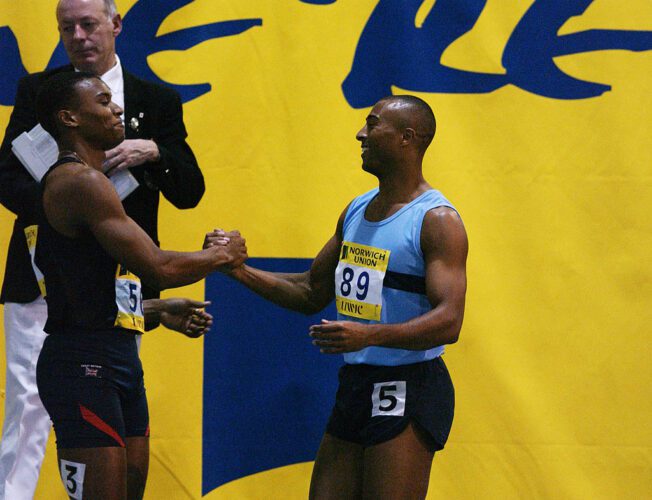
Year-round speed work
“Speed: you either use it or lose it”, Elliott starts; which gives a hint as to what he’s about to say when it comes to keeping your leg turnover as quick as possible as you get older.
Elliott admits that when he was younger, he sometimes followed the more “traditional” seasonal model of having a month off in August or September, then coming back and doing long, hard, slow reps for the first few months of winter conditioning.
It’s a process that most of us, including myself, will be familiar with, but one that Mensah says just doesn’t work for older athletes.
“I do a good solid winter on the track doing the hard, endurance stuff, but I still maintain my speed,” he says.
“Usually I do very little full hurdling until around December. I do hurdle walkovers, all of my hurdle- specific gym work, and loads of sprint work to keep my fast-twitch fibres firing,” he explains.
In Elliott’s opinion, going weeks and weeks without stretching your legs out to over 70% speed just means you’ll have to work harder to get it back, and risk injuring yourself when you do go flat out.
And he combines his year–round sprinting with a gym exercise he’s added to his repertoire as a master’s athlete: weighted walking lunges.
“I’ve found these have really helped me maintain my speed, and my stride length,” he says. “I do them in most sessions, for a few sets over 15 metres using 10kg dumbbells. They’re something I’d recommend that every master sprinter and hurdler add to their training.”
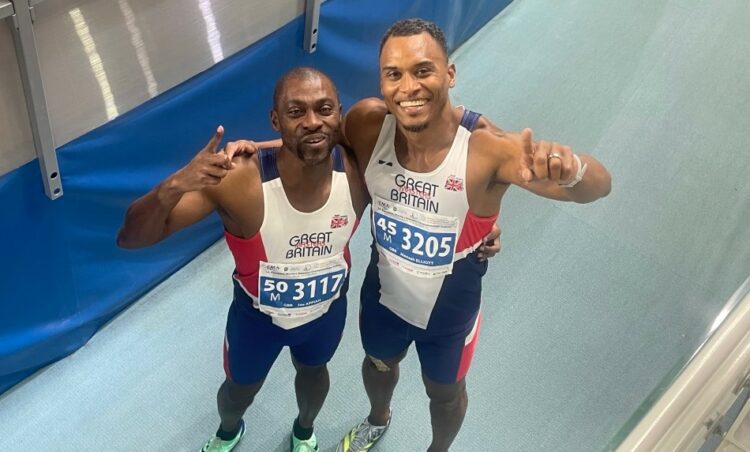
The basics work when it comes to drills
Not everything has changed in Elliott’s training as he’s gotten older: his hurdles drills remain largely the same.
“I still do all of the ‘traditional’ hurdles drills I’ve always done: trail leg, lead leg, walkovers, often with resistance bands”, he says. “I’ll simulate my trail leg pulling through, either by fixing a resistance band to something or using ankle straps on the cable machine”, he explains. “It’s all about strengthening my muscles in the position they’ll be in during the race – that’s really worked for me as I’ve progressed as a masters athlete.”
And just because your hurdles might be getting lower in competition, doesn’t mean they need to in training especially when doing the slower hurdles drills, such as walkovers. Walking drills over higher hurdles is a staple in Elliott’s training: “As we get older, you could be forgiven for thinking that you always need to keep the hurdles lower, but if you can walk over slightly higher hurdles, then do – they’re great for mobility, flexibility, and strength throughout the hurdle motion”, he explains.
“But when it comes to the running drills, 80% of the time I lower my hurdles by three or six inches in order to focus on my technique”.
Look out for part two of this feature coming soon.







